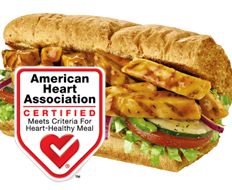The American Heart Association’s (AHA) heart-check mark that has been on grocery-store products for 17 years is now extending to the restaurant industry, with a certain sandwich chain paving the way.
Last month, Subway became the first restaurant chain to participate in the AHA’s Heart-Check Meal Certification program, a two-year pilot program in which menu items that meet the required nutritional criteria can display the AHA’s Heart-Check mark.
“Subway is very proud to be the first restaurant chain to receive this certification,” says Lanette Kovachi, R.D., senior corporate dietician at Subway. “We look at this as a third-party endorsement and as an extra opportunity to educate consumers regarding healthier options. It’s not just us telling our customers that we have healthier choices; now it’s the AHA, a trusted organization, delivering that message. And for us, it’s a continuation of what we already do, and something that our customers have come to expect from us.”
The program is based on various nutritional criteria, including limits for calories, total fat, saturated fat, cholesterol, trans fat, and sodium. It also includes a minimum level of one of six beneficial nutrients. Subway qualified by fortifying breads with nutrients and fiber, setting strict calorie and fat criteria, reducing sodium by nearly 30 percent in FRESH Fit sandwiches, removing artificial trans fats, and offering a large variety of sandwiches that are low in saturated fats and cholesterol.
The Heart-Check mark will be included on Subway’s menu panels, in-store promotional pieces, nutrition brochures, and website.
“We are proud of Subway for being a thought-leader in providing consumers options to eat healthier on the go by meeting our Heart-Check Meal Certification criteria as our first adopter,” says Dennis Milne, director of the food certification program for the AHA. “Consumer research shows that the AHA is the most trusted in terms of an organization to determine if a food can display a nutrition icon. The move to certify qualifying Subway meals extends the trust and credibility of the AHA to help consumers make heart-healthy selections when eating away from home.”
Indeed, having certifications like this can boost consumer perception and trust when it comes to healthy eating, says Greg Prang, senior ethnographic analyst at the Hartman Group, a Bellevue, Washington–based consumer insights firm.
“Most consumers are uncertain what most certifications mean, but find them reassuring and positive elements on packages if they are relevant to the category or brand proposition,” Prang says. “Placing certifications next to menu items can help to extend a halo of healthfulness for a foodservice provider. But much depends on the health halo already associated with such an outlet; for example, Subway has worked for years to bolster its image as a provider of fresh, low-fat fast-food options.
“So in the consumer’s mind, adding a heart-healthy symbol just works to extend the health halo, since freshness is a cue to healthfulness.”
The certifications also communicate a higher-quality experience, Prang says, which diners are looking for.
“Consumers today equate efforts in certain areas of sustainability and health and wellness as beneficial to them and as symbolic of efforts to provide products and services that are higher quality,” he says. “In particular, they are most interested in efforts that benefit themselves and their community, like social efforts and efforts that benefit animals, like ethical practices.”
Certifications need to correspond, however, to a brand’s broader positioning, Prang says. For example, if a company pushes the “sustainability” or “health and wellness” messages, they should certify under those platforms as well. He adds that certifications can communicate transparency and authenticity, and while they don't always immediately boost sales, they do uphold a brand’s health image and relevancy.
Milne says the program will initially work with one quick-serve and one casual-dining restaurant to gain consumer insights on how helpful the program is for customers to identify heart-healthy options.
“Data will be collected to analyze marketing practices and purchase trends of the certified meals and current market trends in the food supply,” he says. “Program enhancements or changes may be made based on evaluation insights, tentatively leading up to a full roll out by June 2014.”
Milne says the AHA hopes the Heart-Check Meal Certification will eventually apply to menu items in restaurants and quick serves throughout the country.
“Subway was the first restaurant chain to apply and meet the nutritional criteria and we are confident we will see other restaurants follow in their footsteps, making healthy choices easier for consumers,” he says.




